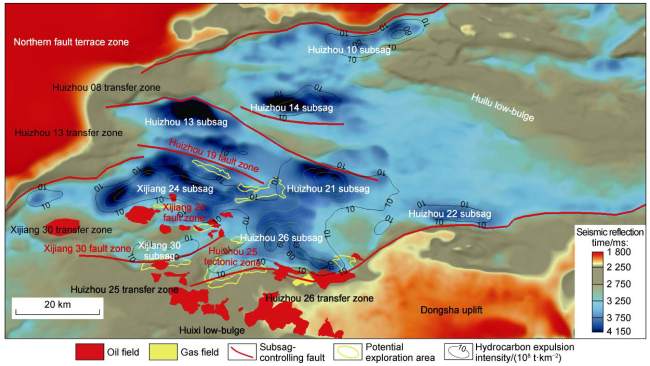High-quality source rocks are the material foundation for the deep oil and gas exploration. The Huizhou 26 subsag among others is the largest in terms of geological resources, proven reserves, and exploration maturity within the Huizhou Sag, which is the most prolific hydrocarbon-generating sag in the PRMB
[4⇓⇓-7,16 -17]. The Huizhou 26 subsag covers an area of approximately 588 km
2, with the Wenchang Formation reaching a maximum thickness of 2 676 m, an average thickness of around 1 034 m, and a maximum burial depth of approximately 7 400 m. In this subsag, the widely distributed black-gray mudstones of semi-deep to deep lake subfacies of the Wenchang Formation serve as the main source rocks. Geochemical analysis on adjacent sampled wells reveals such source rocks having the total organic carbon (TOC) values ranging from 2.3% to 8.1%, with an average of 4.1% (
Fig. 3a), a hydrogen index (HI) ranging from 312 mg/g to 602 mg/g, with an average of 432 mg/g, and an organic matter type classified as II
1-I (
Fig. 3b). Considering the characteristics of biomarkers, these source rocks are identified as typical oil-prone, high-quality source rocks. Moreover, basin modeling results indicate that the main source rocks of the Wenchang Formation entered the mature stage at around 16 Ma before the present (during early deposition of the Hanjiang Formation), with the vitrinite reflectance (
Ro) values of 0.6% to 1.0%. By 10 Ma during late deposition of the Hanjiang Formation, they reached the mid-to- late mature stage, with a
Ro value of 0.8% to 1.3%. Currently, the source rocks have entered a high-maturity stage, predominantly producing gas, with a
Ro value ranging from 1.2% to 1.8%. Recent resource calculations indicate that the Huizhou 26 subsag has a hydrocarbon expulsion intensity of approximately 21.3×10
6 t/km
2. Notably, oil expulsion primarily occurred at approximately 10-23 Ma, with an estimated volume of about 42.44×10
8 t, and the primary gas expulsion period was during 0 to 10 Ma, with an estimated volume of around 23.37×10
8 t. In general, the source rocks exhibit "large oil generation in the early stage and significant gas expulsion in the late stage", typical characteristics of oil-prone source rocks, and provided an abundant material foundation for hydrocarbon accumulation in the deep Paleogene formations in the peripheral areas of the Huizhou 26 subsag.














